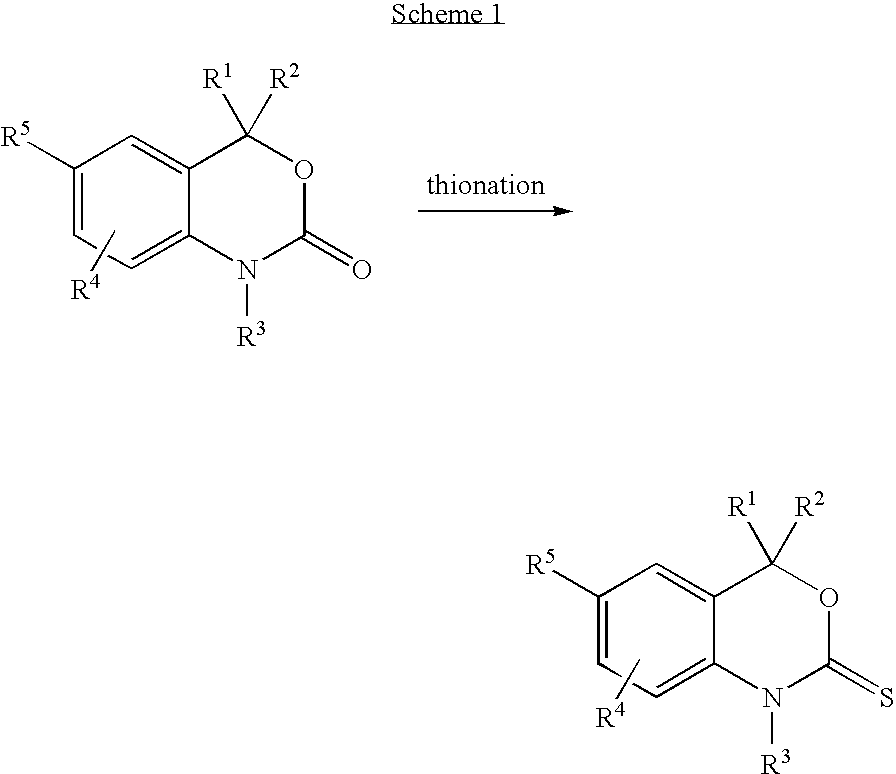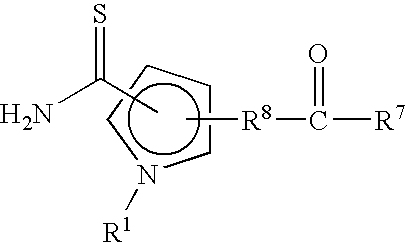Methods for minimizing thioamide impurities
a technology of thioamide and impurities, applied in the field of minimizing thioamide impurities, can solve the problems of difficult removal of certain impurities formed during thionation, and achieve the effect of preventing, reducing or minimizing the formation of thioamide impurities
- Summary
- Abstract
- Description
- Claims
- Application Information
AI Technical Summary
Benefits of technology
Problems solved by technology
Method used
Image
Examples
example 1
Reactivity of Decoy Agents
[0090]One mmol of the aromatic nitrile decoy agents set forth in Table 1 were reacted at reflux with the thionating agent diethyl dithiophosphate (0.2 mL) in wet THF (6 mL) to give the respective thioamides.
[0091]
TABLE 1Nitrile% Conversion to Thioamide*2-thiophenecarbonitrile100 benzonitrile55p-chlorobenzonitrile67p-methoxybenzonitrile45o-nitrobenzonitrile25p-acetylbenzonitrile57p-methylbenzonitrile52p-fluorobenzonitrile68* % conversion as determined by gas chromatography / mass spectroscopy (GC / MS)
[0092]This example illustrates that 2-thiophenecarbonitrile was the most reactive with the thionating agent.
example 2
Use of Decoy Agent During Thionation
[0093]Acetonitrile (21 kg, 512 mol) was utilized as decoy agent in a thionation of 5-(4,4-dimethyl-2-oxo-1,4-dihydro-benzoxazin-6-yl)-1-methyl-1H-pyrrole-2-carbonitrile (34 kg, 126 mol), i.e., a 4:1 molar ratio, using Lawesson's reagent (28.3 kg, 70 mol) in DME (505 kg) at reflux to give 5-(4,4-dimethyl-2-thioxo-1,4-dihydro-benzoxazin-6-yl)-1-methyl-1H-pyrrole-2-carbonitrile (26.7 kg; 74% yield).
[0094]The crude reaction mixture of 5-(4,4-dimethyl-2-thioxo-1,4-dihydro-benzoxazin-6-yl)-1-methyl-1H-pyrrole-2-carbonitrile contained only about 2.6% of 5-(4,4-dimethyl-2-thioxo-1,4-dihydro-benzoxazine)-1-methyl-pyrrole-2-thioamide impurity. After recrystallization, the purified 5-(4,4-dimethyl-2-thioxo-1,4-dihydro-benzoxazin-6-yl)-1-methyl-1H-pyrrole-2-carbonitrile was about 99.90% pure.
[0095]When the reaction was performed in the absence of the decoy agent, the thioamide impurity was present at about 11 to about 12%.
example 3
Competition Between 2-Thiophenecarbonitidle and Alkyl Nitriles
[0096]2-Thiophenecarbonitrile (1 mmol) was reacted at reflux with diethyl dithiophosphate (200 μL) in wet THF (6 mL) and in the presence of the aliphatic nitrites (1 mmol) set forth in Table 2. The conversion of the undesired thiophene-2-carbothioic acid amide was then measured.
[0097]
TABLE 2Nitrile% Conversion to Thioamide*None75Trichloroacetonitrile46Chloroacetonitrile40Malononitrile54Acetonitrile71*Technical grade of diethyldithiophosphate was utilized.
[0098]This example illustrates that conversion of a reactive nitrile, such as 2-thiophene carbonitrile, to the thioamide impurity is high when no decoy agent is utilized. However, conversion to the thioamide impurity is decreased when decoy agents are utilized.
PUM
| Property | Measurement | Unit |
|---|---|---|
| Volume | aaaaa | aaaaa |
| temperature | aaaaa | aaaaa |
| temperature | aaaaa | aaaaa |
Abstract
Description
Claims
Application Information
 Login to View More
Login to View More - R&D
- Intellectual Property
- Life Sciences
- Materials
- Tech Scout
- Unparalleled Data Quality
- Higher Quality Content
- 60% Fewer Hallucinations
Browse by: Latest US Patents, China's latest patents, Technical Efficacy Thesaurus, Application Domain, Technology Topic, Popular Technical Reports.
© 2025 PatSnap. All rights reserved.Legal|Privacy policy|Modern Slavery Act Transparency Statement|Sitemap|About US| Contact US: help@patsnap.com



